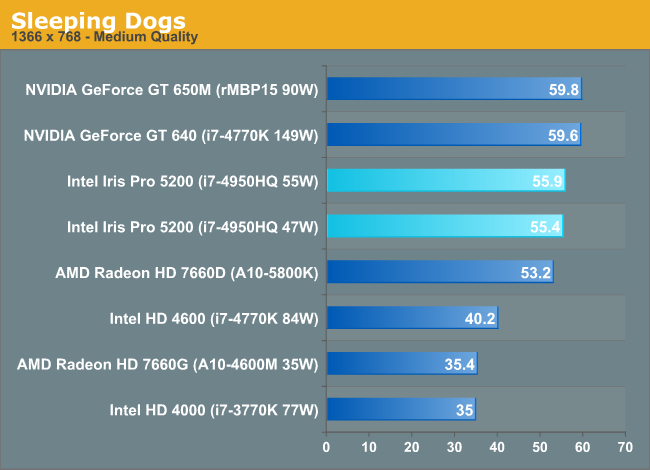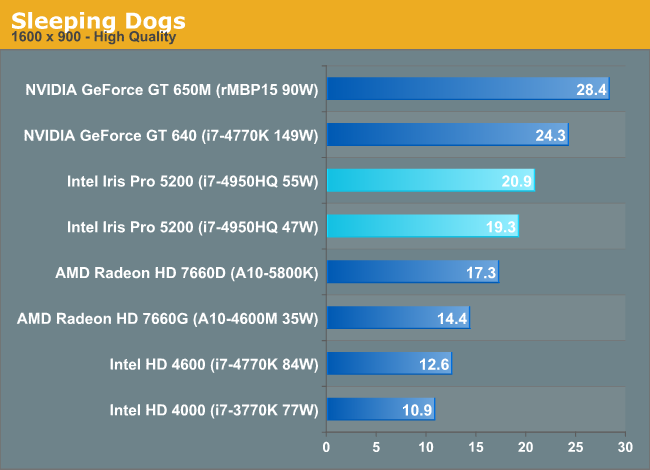Intel Iris Pro 5200 Graphics Review: Core i7-4950HQ Tested
by Anand Lal Shimpi on June 1, 2013 10:01 AM ESTSleeping Dogs
A Square Enix game, Sleeping Dogs is one of the few open world games to be released with any kind of benchmark, giving us a unique opportunity to benchmark an open world game. Like most console ports, Sleeping Dogs’ base assets are not extremely demanding, but it makes up for it with its interesting anti-aliasing implementation, a mix of FXAA and SSAA that at its highest settings does an impeccable job of removing jaggies. However by effectively rendering the game world multiple times over, it can also require a very powerful video card to drive these high AA modes.

At 1366 x 768 with medium quality settings, there doesn't appear to be much of a memory bandwidth limitation here at all. Vsync was disabled but there's a definite clustering of performance close to 60 fps. The gap between the 650M and Iris Pro is just under 7%. Compared to the 77W HD 4000 Iris Pro is good for almost a 60% increase in performance. The same goes for the mobile Trinity comparison.

At higher resolution/higher quality settings, there's a much larger gap between the 650M and Iris Pro 5200. At high quality defaults both FXAA and SSAA are enabled, which given Iris Pro's inferior texture sampling and pixel throughput results in a much larger victory for the 650M. NVIDIA maintains a 30 - 50% performance advantage here. The move from a 47W TDP to 55W gives Iris Pro an 8% performance uplift. If we look at the GT 640's performance relative to the 5200, it's clear that memory bandwidth alone isn't responsible for the performance delta here (although it does play a role).
Once more, compared to all other integrated solutions Iris Pro has no equal. At roughly 2x the performance of a 77W HD 4000, 20% better than a desktop Trinity and 40% better than mobile Trinity, Iris Pro looks very good.










177 Comments
View All Comments
whyso - Saturday, June 1, 2013 - link
They are completely different systems making power consumption values irrelevant.codedivine - Saturday, June 1, 2013 - link
Hi folks. Can you post the OpenCL extensions supported? You can use something like "GPU Caps viewer" from Geeks3d.tipoo - Saturday, June 1, 2013 - link
Interesting that the compute is punches above it's game performance weight. I wonder if they could put more EUs in a chip, maybe a larger eDRAM, and put it on a board as a compute card.lmcd - Saturday, June 1, 2013 - link
They already have a compute card called Xeon Phi if I remember correctly.Klimax - Sunday, June 2, 2013 - link
Different Arch (X86 in Phi)tipoo - Sunday, June 2, 2013 - link
I'm aware, but the Xeon Phi requires completely different programming than a GPU like this which can just use OpenCL.Soul_Master - Saturday, June 1, 2013 - link
What's your point for comparing desktop GPU with middle-range mobile GPU? CPU on both devices are not equal.Soul_Master - Saturday, June 1, 2013 - link
Sorry. I misunderstood about i7 4950HQ process, a high-end quad-core processor for laptops.Ryan Smith - Sunday, June 2, 2013 - link
It's what we had available. We wanted to test a DDR3 version of GK107, and that's what was on-hand.tipoo - Saturday, June 1, 2013 - link
Hmm, so it's heavily hinted at that the next rMBP will ditch discreet graphics. The 5200 is good, but that would still be a regression in performance. Not the first time Apple would have done that, there was the Radeon cut out of the Mini, the 320M to the 3000, even the bottom rung of the newest iMac with the 640m. I wonder if it would at least be cheaper to make up for it.